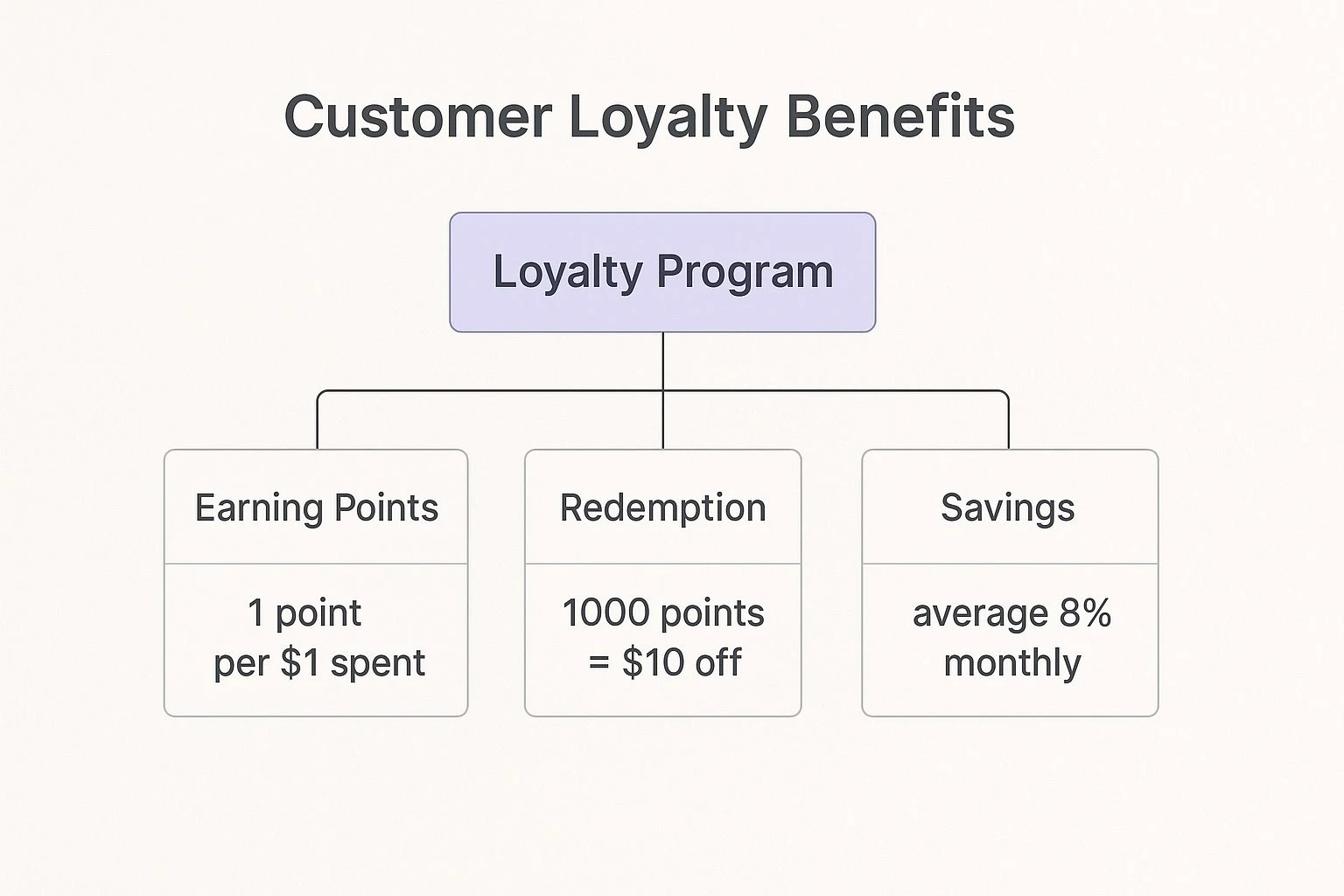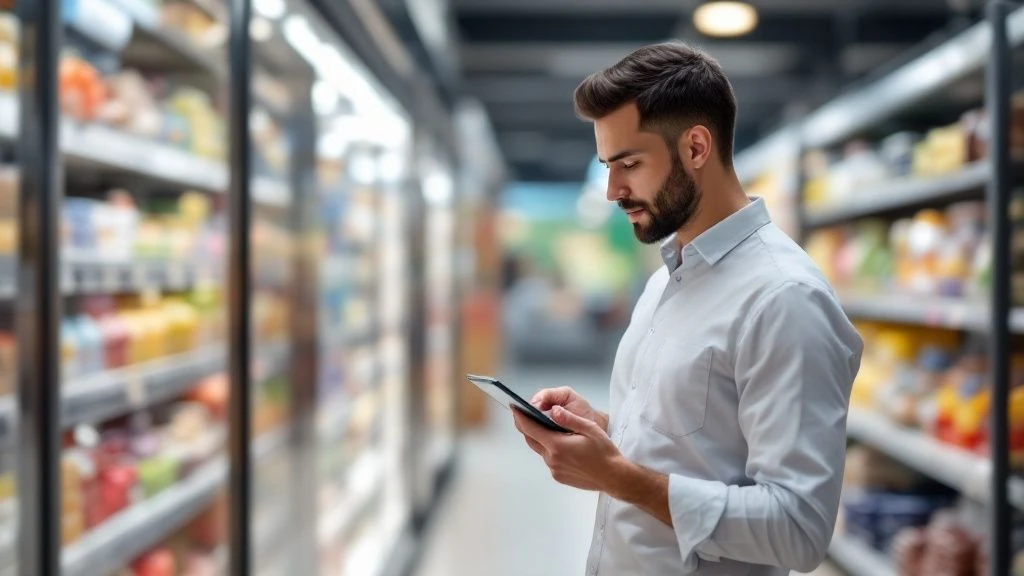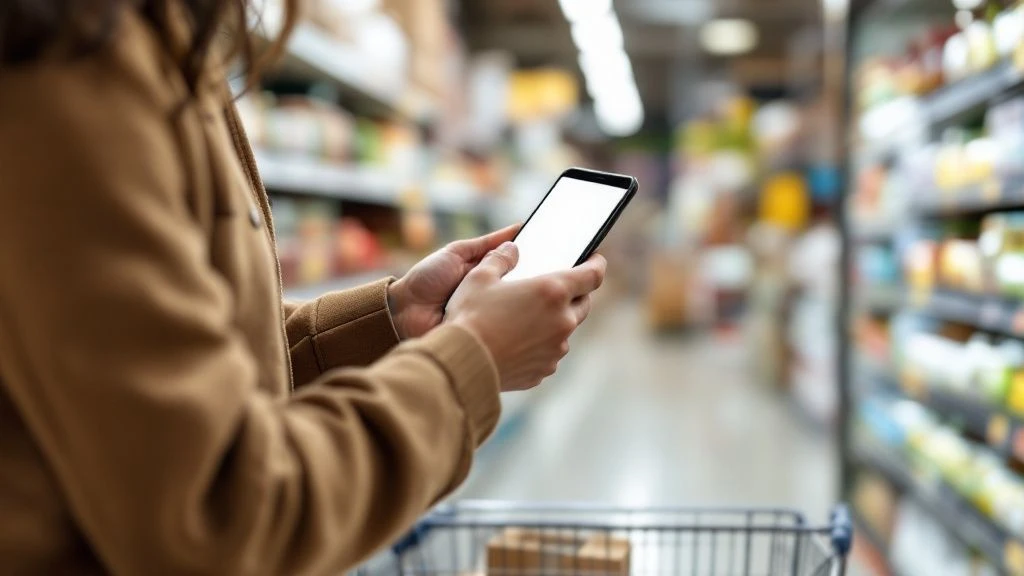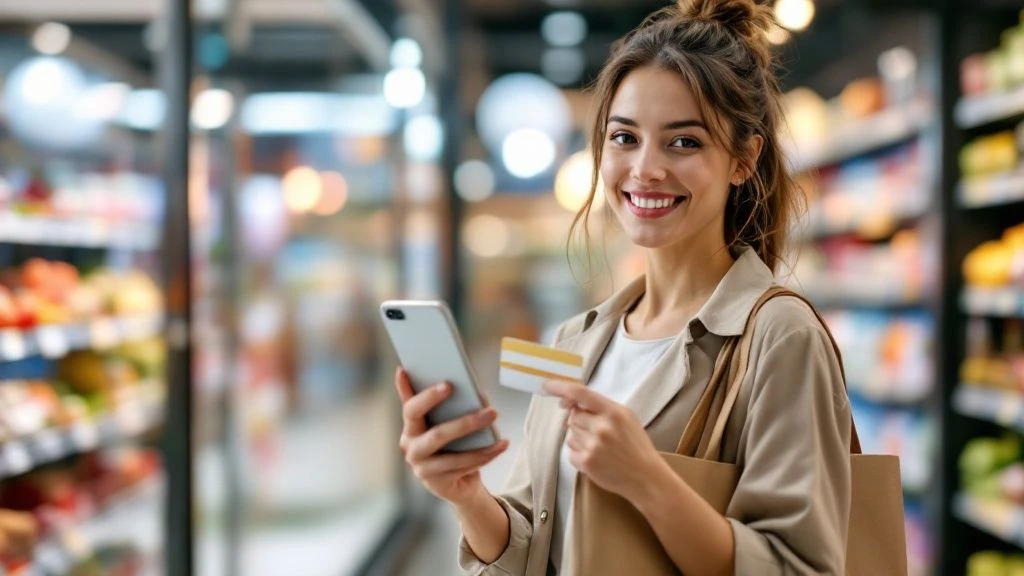Back in the day, a grocery loyalty program might have been a simple paper punch card you kept in your wallet.Get ten stamps, get a free gallon of milk. But things have changed. Today, these programs are sophisticated tools that go way beyond simple discounts—they've become absolutely crucial for customer retention and business growth in a crowded market.
Why Grocery Loyalty Programs Are Essential Today
In a world of razor-thin margins and intense competition, a good grocery loyalty program isn't just a nice-to-have. It’s a survival strategy. Modern grocers are navigating everything from supply chain headaches to rapidly shifting shopper habits, and a well-designed program is one of the smartest ways to stay ahead.
Think of it this way: old-school programs were like a megaphone, shouting the same weekly specials to everyone in the store. The best programs today are more like a personal shopping assistant. They get to know a customer’s habits, figure out what they might need next, and make relevant suggestions that leave shoppers feeling seen and valued.
From Discounts to Data-Driven Relationships
That shift from a megaphone to a personal assistant is everything. A modern program does so much more than knock a few cents off the total bill; it uses data to build a genuine relationship and create a shopping experience that feels tailor-made. This is what truly separates the thriving grocers from the ones just getting by.
A supermarket loyalty program is a strategic tool to boost frequency and margin, with real-time personalization and behavioral targeting. Utilizing the right features, brands can turn everyday transactions into long-term brand equity.
Shoppers are pickier than ever, demanding both convenience and real value for their money. In response, loyalty programs are transforming into complex systems that use technology to offer personalized rewards and even predict what customers will want. You can learn more about how loyalty programs are the bread and butter of the grocery industry over on voucherify.io.
By actually understanding what your customers buy and when, you can start making smarter decisions across the board.
- Improve inventory management: No more guessing games. You can stock the shelves with what your best customers actually want to buy.
- Enhance marketing efforts: Forget generic flyers. You can send offers and deals that are genuinely appealing to specific shoppers.
- Foster community: It’s about making people feel like they’re part of something, not just another number at the checkout line.
Ultimately, these programs turn a routine trip to the store from a simple chore into a rewarding, personalized journey.
Building a Loyalty Program That Actually Works
So, what separates a loyalty program that collects dust from one that customers actually love and talk about? It’s not about just throwing discounts at people. It's about building a system that delivers real, personal value and makes people feel smart for shopping with you.
A modern, high-impact program goes way beyond the transaction. It's about creating an experience. Take tiered rewards, for instance. They aren't just a way to offer bigger discounts to your best customers. They tap into our natural desire for progress and achievement. It gives shoppers a clear goal to work toward, encouraging them to consolidate their spending at your store to unlock those next-level perks. It’s a powerful little psychological hook that can turn a casual browser into a loyal regular.
Personalization Is the Secret Ingredient
But the real magic happens with personalization. Imagine a customer gets a surprise offer for their favorite brand of coffee—not because it’s on a store-wide sale, but because your program noticed they buy it every week. That small, targeted gesture shows you’re paying attention. It makes that customer feel seen and valued in a way a generic weekly flyer never could.
This is where you turn simple shopping data into genuine customer insight. By understanding what people are actually buying, you can craft offers that hit home on a personal level, driving both sales and a much deeper connection to your store.
Creating a Seamless Experience
Finally, the program has to work flawlessly everywhere your customer interacts with you. This is what people mean when they talk about omnichannel integration. A shopper might see a deal on your app while sitting on their couch, add a few things to their digital cart, and then scan their loyalty card at the checkout in-store. The whole journey needs to feel like one smooth, connected experience.
If your program is clunky, disconnected, or just plain confusing between your online and physical stores, it’s going to create frustration. The goal is to make sure that no matter how someone chooses to shop, they feel like they're part of the same rewarding ecosystem.
The infographic below breaks down the simple but powerful value proposition for a customer in a basic points program.

This visual shows how a clear, easy-to-understand value exchange—earn points, get real savings—is the bedrock of any successful program.
Of course, to make your rewards truly compelling, the system behind them needs to be both simple and valuable. For a deep dive into structuring your rewards, check out our guide on how to create a points system for your loyalty program.
Comparing Traditional vs Modern Grocery Loyalty Programs
The loyalty landscape has changed dramatically. What worked a decade ago—simple punch cards and generic discounts—no longer cuts it. Today's programs are smarter, more personal, and deeply integrated into the entire shopping experience.
Here’s a look at how the old way stacks up against the new.
| Feature | Traditional Program (The Old Way) | Modern Program (The New Way) |
|---|---|---|
| Rewards | Generic, one-size-fits-all discounts (e.g., $5 off $50) | Personalized offers based on individual purchase history |
| Customer Interaction | Passive; customers show a card at checkout | Active; push notifications, in-app offers, and email |
| Data Usage | Basic tracking of total spend | Deep analysis of buying habits, frequency, and preferences |
| Experience | Disconnected; separate online and in-store promotions | Omnichannel; a seamless, unified experience across all platforms |
| Goal | Encourage repeat transactions | Build a genuine, long-term customer relationship |
As you can see, the shift is from merely rewarding transactions to actively building relationships. Modern programs use data not just to sell more, but to understand and serve customers better, creating a loyalty loop that benefits everyone.
By weaving together these essential elements—smart tiers, deep personalization, and a seamless experience—you can design a loyalty program that doesn't just offer discounts. You can build one that fosters genuine loyalty and keeps customers coming back for years. That’s the difference between a program that just exists and one that truly thrives.
Unlocking Measurable Business Benefits

A great loyalty program does more than just make customers feel appreciated—it delivers concrete, bottom-line results that can seriously strengthen your entire operation. It's time to stop thinking of your program as just another marketing gimmick. It's a strategic asset that gives you a direct line to your most valuable shoppers.
The data you get back is a goldmine. It gives you a crystal-clear window into what people are buying, which products are flying off the shelves, and even when your busiest hours truly are. This isn't just trivia; it's actionable intelligence that helps you make smarter decisions everywhere, from the stockroom to the front-end displays.
Turning Insights Into Profit
The most direct payoff comes from using this customer data to drive sales and run a tighter ship. When you know exactly what your loyal customers are buying, you can start optimizing everything.
Here’s a real-world example. A local grocer noticed a small but dedicated group of loyalty members consistently buying oat milk and tofu. By digging into that trend, they realized the demand for plant-based products was quietly growing. So, they created a dedicated plant-based section, sent targeted offers to those specific members, and watched sales climb. A simple observation turned into a profitable new category.
That’s the power of a modern grocery loyalty program in action. It lets you:
- Increase Average Basket Size: Send out personalized offers that nudge shoppers to add one or two extra items to their cart.
- Reduce Product Waste: Use real purchase data to make smarter inventory calls, stocking more of what sells and less of what spoils.
- Create Brand Advocates: A program that people love turns happy customers into your best marketers—the ones who recommend your store to friends and family.
Loyalty programs are powerful because they transform anonymous transactions into relationships. Each swipe of a card or scan of an app tells a story, and learning to read those stories is the key to sustainable growth.
Driving Revenue and Market Share
Ultimately, all these small wins add up to hitting your biggest business goals: boosting revenue and carving out a stronger position in the market. A well-run program creates a loyal base that’s far less likely to be swayed by a competitor’s weekly flyer, giving you a much more stable and predictable stream of income.
The growing importance of these programs is impossible to ignore. The global loyalty management market was valued at around $13.31 billion in 2024 and is expected to rocket to $41.21 billion by 2032. That explosive growth shows just how essential these programs have become for retailers of all sizes.
By leveraging the data from your program, you can make informed choices that not only keep your best customers coming back but also actively grow your business from the inside out. You can learn more about how to track these key metrics by exploring our guide on loyalty program analytics and stats.
Theory is great, but let's be honest—seeing what works in the real world is where the real lessons are. By looking at the big players in the grocery game, we can move past just listing features and start understanding the strategies that actually get people hooked. The best programs aren't just about saving a few cents; they're masterclasses in customer engagement.
Take Kroger, for instance. They built a massively successful program around a single, powerful idea: fuel rewards. With Kroger Plus, shoppers earn points on every dollar they spend in-store, which they can then cash in for serious discounts at the gas pump. It's a brilliant move. They extended the program's value way beyond the grocery aisle, turning a weekly chore into a way to save on another huge household expense. That’s a real, tangible reward that hits home for a massive chunk of their customer base.
Gamification and App Engagement
Another killer strategy? Using gamification to drive daily interaction. Lidl, a huge European retailer, absolutely nails this with its Lidl Plus app. It's not just a digital coupon book. The app is packed with features like digital scratch cards and challenges that unlock extra savings.
This completely changes the game. It shifts the loyalty experience from something passive to something active and fun. It gives customers a reason to open the app all the time, keeping Lidl top-of-mind and turning engagement into a rewarding little habit. Those small, consistent interactions build a much stronger bond than a simple "spend-and-get" points system ever could.
The best loyalty programs don't just reward you for buying things; they build an entire ecosystem of value. Whether it's through smart partnerships or fun app experiences, the goal is to weave the brand into the customer's daily life.
Lessons for Small Grocers
So, you might not own a chain of gas stations, but the core ideas here are totally up for grabs. The success of these giants really boils down to a few key takeaways:
- Offer Value Beyond Discounts: Think about who you can team up with locally. Could you offer a discount at the neighborhood coffee shop or car wash? Get creative.
- Make Engagement Easy and Fun: You don't need a massive budget. Even simple digital features can make your program feel more interactive and modern.
- Personalize the Experience: Use the data you have. Send offers that feel like they were picked just for that shopper. It shows you're paying attention.
By breaking down what makes these big programs tick, you can find practical ideas to try yourself. For a closer look at how you can build a powerful and affordable system, check out the features of a modern loyalty application for a grocery store.
Your Guide to Launching a Winning Program
Launching a grocery loyalty program isn't just about picking some software and calling it a day. It’s about building an experience—one that feels valuable and completely effortless for your customers. A truly great program starts with clear goals. Before you do anything else, you need to define what success actually looks like for your store.
Is the main goal to get people to add one more item to their basket? Or is it to turn once-a-month shoppers into weekly regulars? Maybe you just want to finally understand what your customers are really buying. Setting specific, measurable targets from the start will guide every single decision, from the rewards you offer to the tech you choose. Without a clear target, you're just guessing.
Know Your Shoppers and Keep It Simple
Once your goals are set, it’s time to focus on who you're building this for. You have to tailor your rewards to what your specific customers actually want. A program for a health-conscious urban market should feel totally different from one designed for a big, family-focused suburban grocery store. The secret is making the rewards feel both relevant and easy to get.
The sign-up process is your first impression, so it has to be dead simple. Nobody wants to fill out a long, clunky form while the line backs up behind them. Make it as easy as typing in a phone number or scanning a QR code. The less friction there is to join, the more people will actually give it a shot.
Your loyalty program shouldn't feel like a chore for customers or your staff. Simplicity is the ultimate feature—if it’s easy to join, easy to use, and easy to understand, people will embrace it.
Don't forget, your team is your program's biggest superpower. Train your staff not just on how the program works, but why it’s a big deal for the business and for the customers. When your cashiers are genuine champions who can quickly explain the perks, it builds trust and drives sign-ups way more effectively than any poster ever could.
Choosing the Right Tools and Measuring Success
You don't need a massive budget to get this off the ground. Many modern point-of-sale (POS) systems come with built-in loyalty features that are perfect for smaller grocers. These tools can help you track customer data and manage rewards without needing a dedicated IT department. It's often best to start simple—maybe with a basic points system—and then expand as you learn what your customers respond to.
After the launch, the real work begins. Think of your program as a living, breathing thing that needs regular attention. You have to keep a close eye on the data to see what’s hitting the mark and what’s falling flat.
Here are the key numbers to watch:
- Enrollment Rate: How many new members are you signing up each week? Is the number growing?
- Redemption Rate: Are people actually cashing in their rewards? A low rate might mean your rewards aren't compelling enough.
- Purchase Frequency: Are your members visiting more often than non-members? This is a huge indicator of success.
- Average Spend: Do your loyalty members consistently spend more per visit?
Use this information to make smart adjustments. If a particular reward is just sitting there, swap it out for something else. If customers go wild for double-points days, schedule more of them! And most importantly, ask for feedback. A quick survey can give you priceless insights to help you build a program your customers don't just use, but genuinely love.
Understanding Global Trends in Customer Loyalty

Here's a hard truth: when it comes to grocery loyalty, what works in one corner of the world might completely flop in another. A successful grocery loyalty program has to be built on the understanding that shopper habits aren't universal. A one-size-fits-all strategy just doesn't cut it.
If you dig into the data, you’ll see that customer behavior and expectations shift dramatically from one market to the next. This is especially clear when you look at how many people actually join loyalty programs—the numbers are sky-high in parts of Europe and Latin America.
Regional Differences in Shopper Behavior
Take France, for example. An incredible 94% of consumers are part of a supermarket loyalty program. The UK isn't far behind, with a solid 82% participation rate. This is a whole different ballgame compared to the United States, where shoppers tend to join several competing programs at once, showing a lot less attachment to a single brand. You can dig into more of these global supermarket loyalty program trends on Statista.com.
The big takeaway here is that cultural context is everything.
While the tactics may differ by region, the core drivers of loyalty remain consistent worldwide: shoppers everywhere are looking for genuine value, seamless convenience, and a personalized experience that makes them feel recognized.
By keeping an eye on these global trends, you can build a much smarter strategy. It lets you ground your program in the universal principles that keep customers coming back, while still tailoring your rewards and messaging to what really clicks with your local audience. It’s this global perspective that will help you build a program that actually works.
Got questions? You're not alone. Digging into grocery loyalty programs always brings up a few key things, especially for independent grocers. Let's clear up some of the most common ones so you can move forward with confidence.
How Much Is This Going to Cost Me?
The real answer? It depends. You can get started with a simple, off-the-shelf digital rewards system without breaking the bank. On the other end of the spectrum, a fully custom mobile app with all the bells and whistles will naturally be a bigger investment.
The smart way to approach it is to figure out your budget first. Once you have a number, you can find a scalable solution that fits your goals right now. Start simple, prove the value, and you can always add more features as your program—and your business—grows.
How Do I Know If It's Actually Working?
Success isn't a gut feeling; it's in the data. The best way to see the impact is to track a few key metrics that tell the real story of what your program is doing.
The ultimate test for any loyalty program is to compare the behavior of your members to your non-members. That difference is where you'll find the proof. It shows you exactly how much the program is influencing how people shop.
Keep a close eye on these numbers:
- Customer Retention Rate: Are members sticking around longer than regular shoppers?
- Average Spend Per Visit: Do loyal customers consistently have fuller baskets at checkout?
- Purchase Frequency: Are your members popping in more often than everyone else?
And don't forget to watch your enrollment and reward redemption rates. Those are your quick-glance indicators of whether the program is actually exciting enough for customers to use.
Can a Small Grocer Really Compete with the Big Chains?
One hundred percent, yes. You just have to play a different game. Big chains compete on massive scale and deep, impersonal discounts. You can win by leaning into what makes you different: your community roots and your ability to be agile.
Your loyalty program is the perfect tool to double down on that advantage. Think about offering exclusive rewards with other local businesses, giving members first dibs on new products from nearby farms, or using it to supercharge the personal service the big guys can only dream of. The technology has leveled the playing field, making it affordable for anyone to build powerful connections.
Ready to build a loyal customer base that keeps coming back for more? BonusQR makes it incredibly easy for small businesses to launch a powerful loyalty program that doesn't break the bank.
